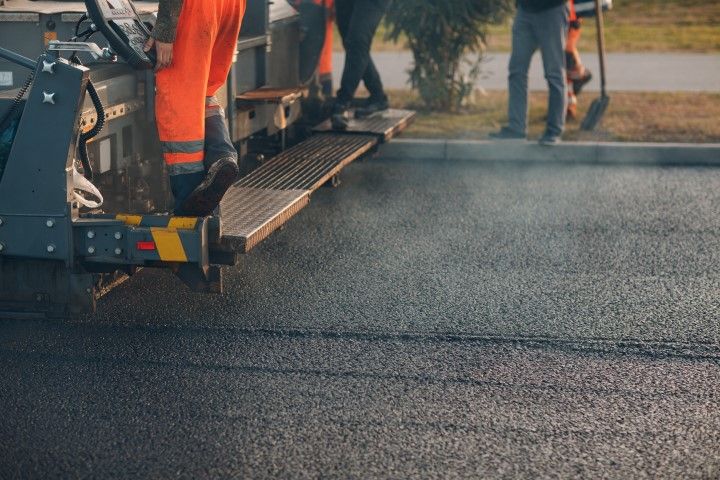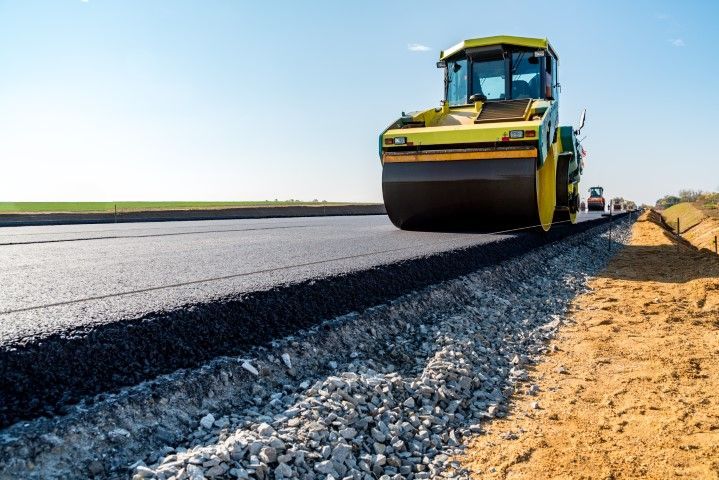Get a Free Estimate Today
Asphalt Paving in Alameda CA
Installing a new asphalt surface is more than just pouring blacktop onto the ground. We follow a proven process to make sure every project we handle is strong, smooth, and long-lasting. Whether it's for a driveway, a parking lot, or a private road, our team takes every step seriously to ensure top-quality results. Here's a look at our 4-step process of asphalt paving in Alameda, CAdesigned with both precision and care.
Step 1: Site Preparation and Demolition
Before we can lay down any new material, we start by preparing the area. This includes removing any old pavement, debris, grass, or rocks. If there's an existing surface that’s damaged or cracked, we’ll tear it out using heavy-duty equipment. We make sure to clear everything down to the base so the new asphalt has a clean and stable surface to rest on. Proper site preparation is key to a durable and even paving job.
Step 2: Grading and Sloping
Once the site is cleared, we begin grading. This step involves shaping the ground to create the right slope for water to run off. Drainage is critical—standing water can weaken the surface and shorten the life of the pavement. Using laser-guided tools, we check and adjust the grade to make sure the water flows in the right direction, away from buildings and toward drains. This prevents problems like cracking, erosion, and potholes down the road.
Step 3: Sub-base Installation and Compaction
Next comes the sub-base. This is a layer of crushed rock that supports the asphalt above it. It acts as a foundation, providing strength and stability to handle heavy loads like cars and trucks. After laying down the sub-base, we compact it thoroughly using rollers. This helps prevent shifting and settling over time. The sub-base also plays a role in keeping the pavement from freezing and cracking during colder months.
Step 4: Asphalt Application and Final Roll
Finally, it's time to apply the hot asphalt. Our crew pours and spreads the material evenly across the prepared base. We then use rollers to press it down and smooth it out. This final compaction step locks everything into place and removes any air pockets. Once the surface cools, it becomes solid and ready for use. From here, your new asphalt is ready to stand up to daily wear and tear.
With years of experience and a trusted process, we make sure every job is done right the first time. Whether you need a new driveway or a larger concrete paving project, we're here to make it happen. Contact us today to learn more or to get a free estimate. Let’s get your paving project started—one solid step at a time.
How Weather Affects Asphalt Paving and Longevity
Asphalt paving is an investment you expect to last for years. However, many people do not realize how much the weather can impact the quality and life span of asphalt surfaces. From intense heat to freezing cold, different weather conditions can affect how asphalt is installed, how it cures, and how it performs over time. Understanding these factors helps you protect your driveway, parking lot, or road and keep it looking smooth and safe for as long as possible.
Temperature During Installation
The temperature when asphalt is installed is critical. For the asphalt to set properly, it must be applied at the right heat level. If it is too cold, the asphalt cools too quickly and does not compact as it should. This can lead to weak spots, cracks, and early failure. On the other hand, if it is extremely hot outside, the asphalt can stay too soft for too long, making it vulnerable to ruts and marks from vehicles. Ideal paving happens in mild, warm weather, which allows the mix to spread evenly and settle correctly.
Moisture and Rain
Water is one of the biggest threats to asphalt paving. Rain during installation can prevent proper bonding between layers. If water gets trapped under the asphalt, it can cause the base to weaken, leading to potholes and surface damage over time. Even after the paving is complete, standing water can seep into small cracks, freeze, and expand in colder months, breaking apart the surface. This is why good drainage and sealing are so important to help keep moisture from causing problems.
Sun and UV Exposure
The sun’s rays can gradually wear down asphalt over the years. Ultraviolet light breaks down the binders that hold the asphalt together, causing the surface to become dry and brittle. This aging process often leads to cracks and fading color. In hotter climates, the constant heat can also soften asphalt, making it more prone to tire marks and dents. Sealcoating the asphalt surface every few years helps shield it from sun damage and keeps it looking fresh.
Freeze and Thaw Cycles
In places with cold winters, freeze-thaw cycles are a serious concern. When water gets into small cracks in the asphalt and freezes, it expands and pushes the material apart. As temperatures rise, the ice melts, leaving gaps behind. Repeated freezing and thawing cause cracks to grow larger and can eventually lead to potholes or complete failure of the pavement. Regular inspections and prompt repairs are necessary to limit the damage from these cycles.
Protecting your asphalt from weather-related damage starts with quality installation and continues with proper care. Our team understands how local weather conditions affect asphalt paving and can recommend the best solutions for your property. Whether you need new paving, sealcoating, or repairs, we are here to help keep your surfaces in top shape all year round. Contact us today to learn more about our services or to schedule a free consultation. Let us help you get the longest life and the best results from your asphalt investment.
Cost Factors in Asphalt Paving: What Homeowners and Businesses Should Know
When you are planning a new asphalt surface for your home or business, understanding the costs involved can help you set a realistic budget. Whether you need a fresh driveway, patio, parking lot, or private road, there are several important factors that can affect the total price. By learning about these cost elements, you can make smart decisions and avoid surprises along the way.
Size and Layout of the Area
The size of the area you need paved is one of the main things that determines the overall cost. Larger surfaces require more materials, labor, and time to complete. In addition, the shape and layout of the space can impact expenses. A simple, flat rectangle will usually be less expensive to install than an area with many curves, slopes, or tight corners that demand extra work and precision.
Preparation and Base Work
Before any asphalt can be applied, the base beneath it must be prepared properly. This involves grading the soil, adding layers of crushed rock or gravel, and making sure the base is stable and drains water away. If your site has poor soil conditions or old paving that needs removal, the preparation phase can add to the cost. A strong base is essential because it supports the asphalt and prevents cracking and sinking later on.
Thickness and Type of Asphalt
Another factor is the thickness of the asphalt layer itself. Thicker applications last longer and withstand heavier loads, but they cost more due to the additional material needed. You may also be able to choose from different types of asphalt mixes. Some are designed for high-traffic areas, while others are better for light residential use. Your paving contractor can explain which mix makes sense for your project and how it affects the price.
Labor and Equipment Costs
Asphalt installation requires skilled workers and specialized machines. Labor charges will vary based on the size of the crew, their experience, and how long the job takes. Equipment costs also come into play, especially if large rollers, pavers, or trucks are needed to transport materials. If your property has limited access or requires extra time to set up equipment, this can raise the overall expense.
Beyond these four main factors, other things—like permits, disposal fees for old materials, and finishing touches such as striping or seal coating—can increase the total investment. It is always wise to request a detailed estimate that outlines all expected costs so you can plan accordingly. Asphalt paving can be a smart way to improve the look, safety, and function of your property. With proper preparation and installation, a new surface can last many years with only routine care. When you understand what drives the price, you are better prepared to work with your contractor and choose the right solution for your needs.
If you have questions about paving costs or would like a free estimate, please reach out to our team. We are here to guide you through every step of the process and help you create a smooth, long-lasting asphalt surface you can trust.

